Best Upselling Strategies for Content Entrepreneurs
You’re running a thriving content business, and audiences love your work. But your revenue growth remains sluggish.
What’s missing? Killer upselling strategies.
Upselling offers customers extra services that complement their purchases. It isn’t just a sales trick. It’s a way to provide extra value while boosting your bottom line and strengthening relationships.
However, many content entrepreneurs shy away from upselling, fearing it might seem pushy. However, with the right techniques, your customers will gladly spend more.
Unsure which upselling strategies fit your business? This article will help.
1. Understanding your audience: The key to effective upsellingKnowing your audience inside and out can make all the difference for your lead generation and upselling efforts. Here’s how to do it:
Identifying customer needs and preferencesIn a key client meeting, you wouldn’t present a generic proposal. Instead, tailor it to the client’s specific needs. The same goes for upselling — know your customer’s unique preferences and customize your offer accordingly.
You can do it effectively by following these best practices:
Analyze purchase historyCheck what content your customers love — guides, case studies, instructional videos, articles, or podcasts. Then, look at what they’ve bought in the past — ebooks, courses, memberships, or one-on-one consultations.
Additionally, see if they’ve picked up complementary products, like a webinar with an ebook. And review their feedback to spot what they like and what needs tweaking.
For example, Sarah bought a beginner yoga course along with webinars on meditation and nutrition, showing her love for holistic wellness. The course creator can use this insight to upsell advanced yoga courses, wellness bundles, or personalized coaching sessions. It’s also a good way to monetize video content.
Monitor competitor offeringsKeep tabs on what your competitors are offering to spot industry trends and gaps. If they’re bundling online yoga classes with wellness guides, outshine them with exclusive diet plans or personalized one-to-one sessions.
Segment your customersDivide your audience by interests or behavior. For instance, target fitness fans with advanced workout plans and mindfulness seekers with stress relief courses.
Combine this with detailed customer profiles, like “fitness fanatic” or “mindfulness maven.” These personas reveal their motivations, allowing you to craft upsell offers that hit the mark.
You can also use CRM (customer relationship management) tools to track interactions — website visits, email opens, and social media engagement — to build detailed profiles based on interests, purchase history, and timing.
Using audience insights for personalized offersOnce you’ve gathered insights, leverage them to create personalized upsell offers.
Personalized upsell offers can enhance the customer’s experience by offering something they didn’t know they needed but now can’t resist. This makes people feel valued and drives more sales.
Here’s how you can do it:
- Mention the customers’ previous actions in your upsell offer, like, “Since you’ve been exploring our blog and webinars about billing, enjoy a free week of access to our premium software.”
- Address your audience personally to avoid a generic pitch. Personalize your messaging to resonate more with them.
- Deliver upsell offers at the right moments, like suggesting an advanced workshop or ebook right after the user completes a beginner’s course.
You can also offer related products or courses in follow-up communications after users attend your webinar. And create personalized landing pages to guide them to upsell offers based on their past interactions.
2. Crafting irresistible upsell offersJust making a personalized offer isn’t enough — you need to make it so compelling customers can’t wait to say yes. Here’s how to make that happen.
The art of packaging content productsIf you want your upsell offers to pop, you should combine related content products in a way that stands out and entices users.
For example, instead of selling just a premium ebook, bundle it with a mini-course or exclusive templates. Or, pair a blogging guide with custom editorial calendars and planning tools.
This turns your offer into a complete package, not just an add-on. However, ensure the bundled products match the customer’s interests and needs for a seamless, enhanced experience.
Lizzie Davey upsells by providing users with extra, like exclusive templates and one-on-one coaching with her courses like Pitch & Prosper PRO. This bundle delivers premium value, ensures client satisfaction, and drives revenue with irresistible all-in-one solutions. The benefits include two one-on-one sessions, in-depth training, individual tutorials, a template and script library, a prompt guide, an interactive pitch tracker, follow-up email scripts, and feedback on three pitches.
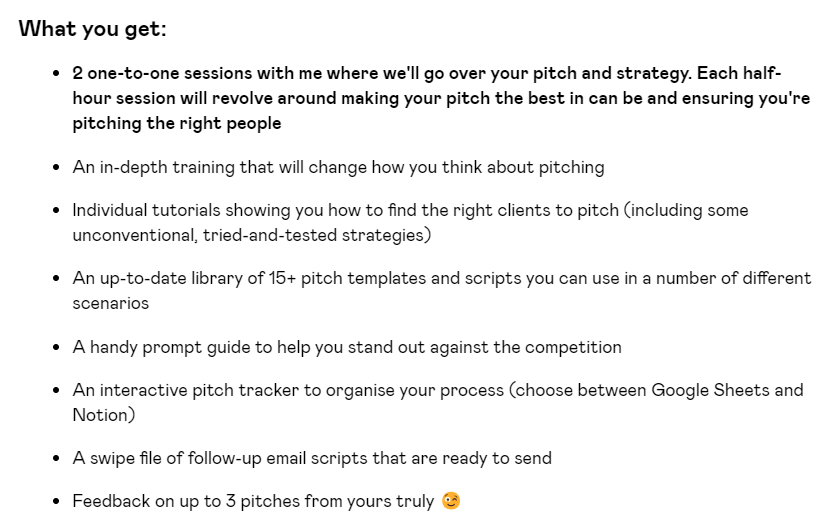 Source: https://lizziedavey.gumroad.com/l/pitchprosperpro?layout=profile
Source: https://lizziedavey.gumroad.com/l/pitchprosperpro?layout=profile
To create a tempting product package:
- Keep it simple: Avoid overwhelming customers with tons of choices. Offer a few well-curated bundles that directly meet their needs or goals.
- Use limited-time offers: Promote bundles with a time-sensitive discount or bonus content to get customers to act fast before it’s gone.
- Elevate your packaging game: Use high-quality design and eye-catching visuals to make your bundles look premium and desirable.
- Pair high and low-value items smartly: Make sure they deliver real value and fit well together. Otherwise, customers might feel tricked and skip your bundles.
Additionally, showcase the bundle’s benefits upfront so customers instantly see the impact. You can also use testimonials or case studies to make your offer more convincing.
Regularly test different bundle combinations with your billing software to find what works, and use these insights to refine your offers.
Strategic pricing models for upselling successTo ace upselling strategies, your pricing model needs to be spot-on.
A clear pricing model shows each option’s value, making it easier for customers to see why upgrading is worth it. Plus, it keeps you competitive by showcasing compelling value propositions that set you apart.
Here are a few popular pricing plans to choose from:
1. Tiered pricingTiered pricing offers different versions of a product or service at varying price points, each with additional features. This lets customers pick what suits them best while tempting them to upgrade for more comprehensive features.
As an online business coach, your pricing model can include:
- Basic tier with an ebook on business fundamentals
- Mid-tier with a detailed guide and actionable templates
- Top tier with live webinars, personalized one-on-one sessions, and access to exclusive mastermind groups
Pat Flynn, founder of Smart Passive Income, offers two membership tiers — an all-access pass for early-stage entrepreneurs ($199 a quarter) and SPI Pro for seasoned pros ($299 a quarter). SPI Pro includes everything in the all-access pass plus exclusive perks like a network of trusted pros, curated member masterminds, and in-house expert access.
Pat also distinguishes between the two by asking all-access pass customers to join them and inviting SPI Pros to apply for the program.
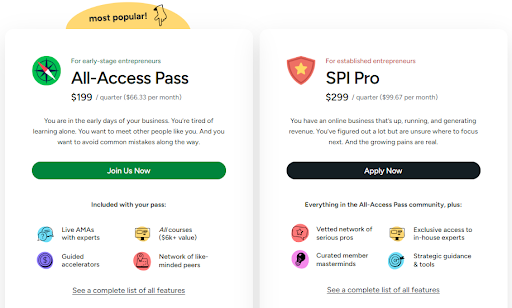 Source: https://www.smartpassiveincome.com/pricing/
2. Subscription pricing
Source: https://www.smartpassiveincome.com/pricing/
2. Subscription pricing
Subscription pricing involves charging for ongoing access to exclusive content, courses, and community memberships. To boost upselling, you can bundle premium products at a discount to make add-ons more tempting.
For example, you can introduce advanced courses or personalized coaching as upsells within your community, leveraging the existing trust and engagement. This keeps customers hooked and opens doors for offering them exciting, higher-value offerings.
Jimmy Daly, co-founder of Superpath, uses a subscription pricing model for his Slack community, letting users engage and network with peers for free. They can upgrade to paid plans ($20 a month for the Slack Community tier and $500 a year for Superpath Pro) to access advanced features, such as exclusive content, premium courses, and monthly one-to-one support.
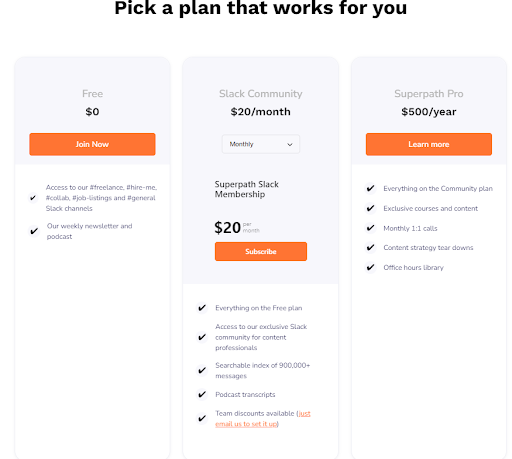 Source: https://www.superpath.co/community
3. Freemium model
Source: https://www.superpath.co/community
3. Freemium model
This model attracts users with free resources to give them a taste of your value. Once engaged, they are more likely to upgrade to pay for advanced tools or exclusive insights.
For example, offer free basic features of your content collaboration tool to attract users. Then, upsell premium options like advanced analytics, integrations, extra templates, or consultancy services to help them get more out of it.
Neil Patel nails the freemium model with Ubersuggest — people can sign up for a free account to test basic tools and use the free trial to unlock advanced features before subscribing. Paid accounts range from $12 a month for individuals to $40 a month for enterprise clients (eight to 15 websites).
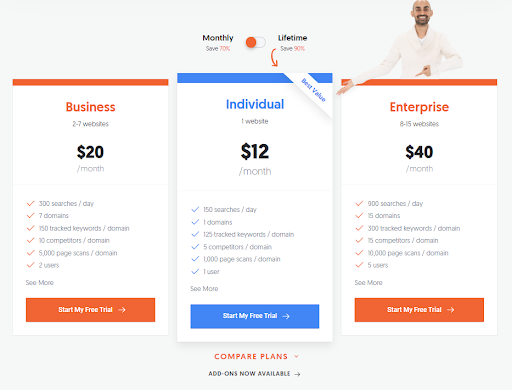 Source: https://app.neilpatel.com/en/pricing
3. Role of technology in upselling strategies
Source: https://app.neilpatel.com/en/pricing
3. Role of technology in upselling strategies
Imagine running an online business where customers love your content but aren’t upgrading to premium offerings. Technology can turn this around, making upselling a breeze. Let’s understand how.
Using analytics tools to monitor successTracking upselling performance is key to spotting what works and what needs fixing. This is where analytical tools come in. These tools allow you to track key metrics like user behavior, conversion rates, customer engagement, and average order value.
For example, set up goals in Google Analytics to track users who download your free ebook and then purchase your paid course. It shows the conversion rate from free content to paid services.
Additionally, use GA4’s path exploration report to see the route users take from downloading the ebook to purchasing the course. This helps you identify drop-off points and optimize your funnel for better conversions.
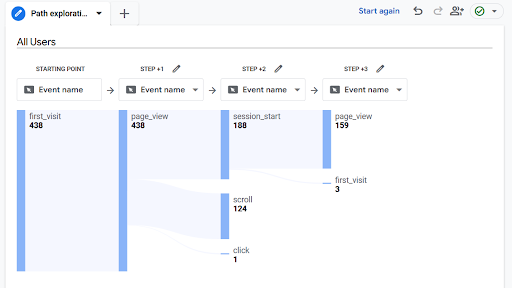 Source: https://easyinsights.ai/blog/guide-to-path-exploration-in-ga4/
Source: https://easyinsights.ai/blog/guide-to-path-exploration-in-ga4/
You can also use analytical tools to:
- Break down performance by user segments, such as age or industry, and identify which is most likely to convert on an upsell.
- Implement A/B testing tools to test upsell offers and see which variations perform better.
- See how your upselling strategies compare to industry benchmarks and competitors.
Imagine having a digital assistant that knows exactly when and how to pitch additional offers and ensure no opportunity is missed. That’s the power of automating your upsell process.
It can transform how you boost sales and turn casual browsers into dedicated customers with minimal manual effort. To kickstart your upsell automation, consider these practices:
- Behavior-based triggers: Trigger upsell offers based on user actions. For instance, if a customer finishes a free course, use a tool like ActiveCampaign to automatically send an email promoting premium content.
- Follow-up sequences: After a user signs up for a free trial, automatically follow up with a series of emails offering higher-value products or memberships.
- On-site pop-ups: Use tools like OptinMonster to implement on-site pop-ups that automatically offer related deals when a user shows interest in specific content.
Lewis Howes uses pop-ups on his website to promote his other website — Greatness.com — when visitors show interest in his programs and books. This one asks visitors if they are ready to unlock their true potential and unleash inner greatness, followed by an explanation and CTA button to visit the website.
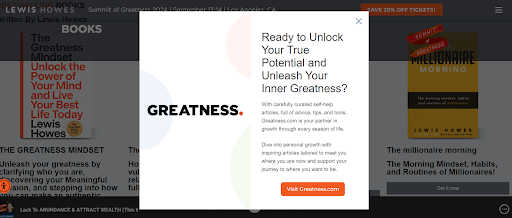 Source: https://lewishowes.com/programs/
Source: https://lewishowes.com/programs/
AI tools can also supercharge your upsell automation by analyzing user data to pinpoint the perfect moments for upsell offers.
By predicting when users are most likely to respond based on their past behavior, AI makes your upselling smarter and more effective. Plus, it seamlessly adapts to changing customer trends to keep your upselling strategies on point.
Elevating your content business through strategic upsellingStrategic upselling is a game-changer for content entrepreneurs who want to boost revenue and delight their customers. It’s all about knowing your audience inside and out, crafting offers they can’t resist, and using tech to streamline your approach.
Here’s the magic: When you deliver real value and customize your offers to fit your audience’s needs, you’re not just boosting your revenue — you’re building stronger, more meaningful connections with your customers.
So, nail these strategies and watch your content business thrive like never before.
Learn revenue opportunities and much more with experts from Content Entrepreneur Expo. Purchase your digital pass today!The post Best Upselling Strategies for Content Entrepreneurs appeared first on The Tilt Publishing.
